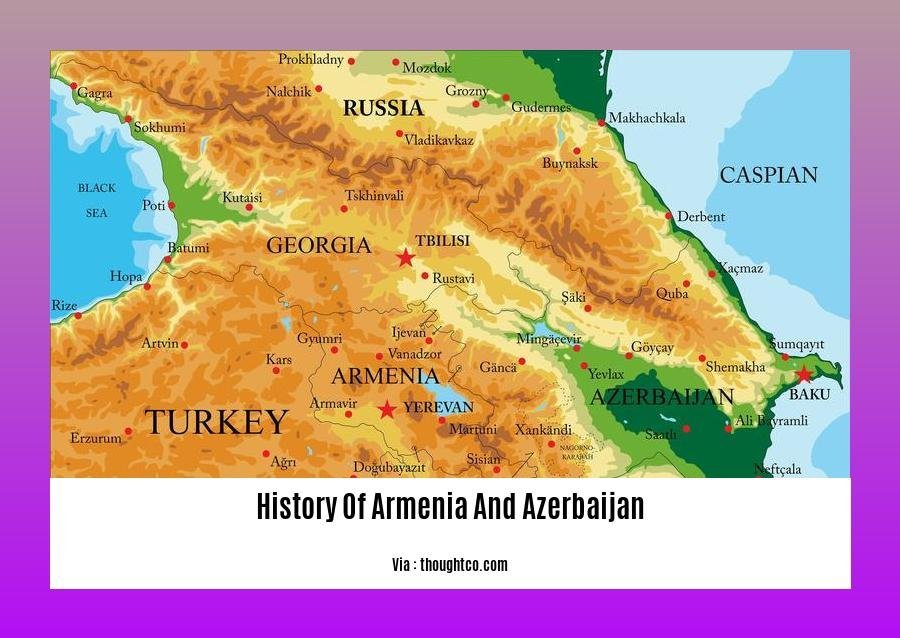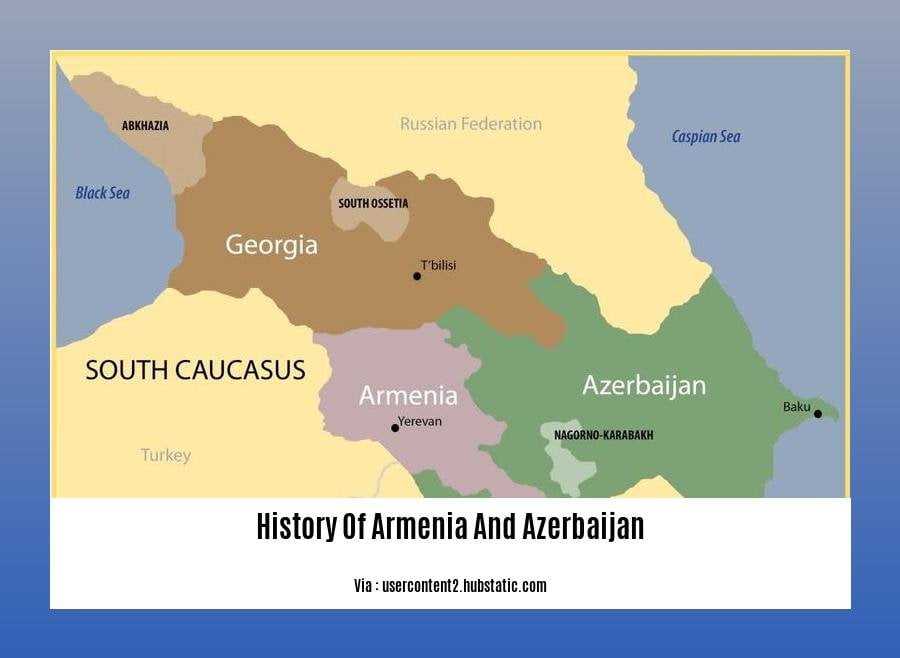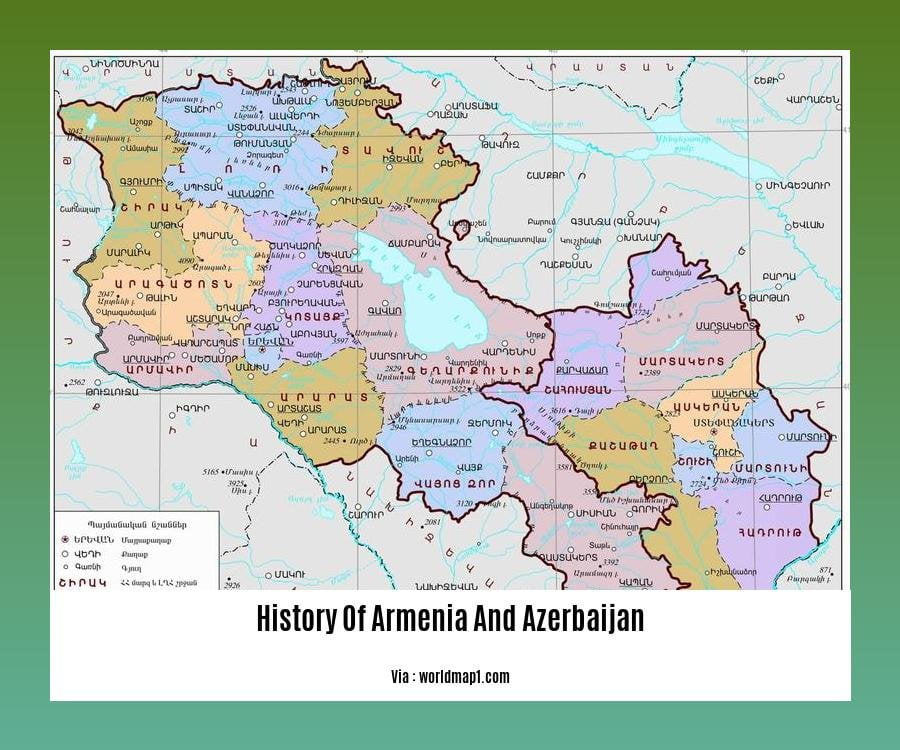Unveiling the rich tapestry of Armenia and Azerbaijan’s shared history, [Exploring the Intricate History of Armenia and Azerbaijan: A Scholar’s Journey] delves into the captivating stories and pivotal events that have shaped these neighboring nations. Join us on an academic odyssey as we uncover ancient manuscripts, archaeological treasures, and historical accounts that illuminate the complexities of their entwined destinies, cultural diversity, and geopolitical influences.
Key Takeaways:
Historically, Armenia and Azerbaijan have experienced conflicts and tensions, including the Armenian-Tatar Massacres in the early 1900s.
The First Republic of Armenia and the Democratic Republic of Azerbaijan had formal relations between 1918 and 1921 during their brief independence.
Currently, Armenia and Azerbaijan maintain no diplomatic relations.
Territorial disputes, mainly over Nagorno-Karabakh, have fueled conflict and led to five wars between the countries.
Hostilities and conflicts have resulted in strained relations and a lack of diplomatic progress toward reconciliation.
The absence of formal relations and ongoing tensions create obstacles to peace and stability in the region.
History Of Armenia And Azerbaijan

In the heart of the South Caucasus, where East meets West, lies a captivating tale of two neighboring nations, Armenia and Azerbaijan. Their shared history is a tapestry of conflicts, cooperation, and cultural exchange, intertwined for centuries.
Ancient Rivalry and Shared Heritage:
The roots of the History Of Armenia And Azerbaijan can be traced back to ancient times, where kingdoms and empires clashed over territory and power. The Armenian Highland, a cradle of civilization, witnessed the rise and fall of various dynasties, while the Caspian Sea region was home to diverse nomadic tribes. Despite their rivalries, these civilizations also engaged in trade and cultural exchange, leaving behind a rich legacy of art, architecture, and literature.
Russian Rule and the Emergence of Nationalism:
In the 19th century, the Russian Empire expanded its influence over the Caucasus, annexing both Armenia and Azerbaijan. Under Tsarist rule, nationalist sentiments began to stir among the Armenian and Azerbaijani populations, fueled by desires for autonomy and self-determination. These aspirations would eventually lead to conflicts and tensions that continue to shape the region today.
Brief Independence and the Nagorno-Karabakh Conflict:
With the collapse of the Russian Empire in 1917, Armenia and Azerbaijan briefly enjoyed independence. However, this newfound freedom was short-lived as both nations were soon embroiled in a bloody conflict over the disputed territory of Nagorno-Karabakh, a majority-Armenian enclave within Azerbaijan. The decades-long struggle resulted in thousands of casualties and displaced populations, leaving deep scars on the relationship between the two countries.
Soviet Era and Tensions:
In 1922, Armenia and Azerbaijan became part of the Soviet Union, where they remained for over seven decades. While the Soviet era brought a degree of stability and economic development, it also suppressed nationalist aspirations and ethnic tensions. The Nagorno-Karabakh conflict simmered beneath the surface, eventually erupting into open warfare in the late 1980s as the Soviet Union began to disintegrate.
Post-Soviet Conflicts and Ceasefire:
With the dissolution of the Soviet Union in 1991, Armenia and Azerbaijan found themselves as independent states once again. The Nagorno-Karabakh conflict reignited, leading to a full-scale war that lasted until a ceasefire was brokered in 1994. However, tensions remained high, with both sides accusing each other of ceasefire violations and cross-border attacks.
International Efforts and Peace Negotiations:
Since the 1994 ceasefire, international organizations and mediators have attempted to facilitate peace negotiations between Armenia and Azerbaijan. The Minsk Group, led by Russia, the United States, and France, has been instrumental in mediating talks and promoting a diplomatic solution to the Nagorno-Karabakh conflict. However, despite ongoing negotiations, a lasting peace agreement has yet to be reached.
Current Relations and Challenges:
The History Of Armenia And Azerbaijan is one of complexity, conflict, and resilience. Despite the challenges they have faced, both nations have made significant progress in various fields, including education, healthcare, and economic development. However, the unresolved Nagorno-Karabakh conflict remains a major obstacle to lasting peace and cooperation between Armenia and Azerbaijan. As the region strives for stability and reconciliation, the international community continues to play a vital role in supporting efforts towards a peaceful resolution.
To gain a profound understanding of Armenia’s ancient civilization and its fascinating journey through time, embark on an enlightening exploration of our comprehensive article: history of Armenia.
Cultural and Ethnic Diversity: The Tapestry of Armenia and Azerbaijan

In the heart of the South Caucasus, where the Armenian Highland and the Caspian Sea region intertwine, lies a tale of rich cultural and ethnic diversity. Armenia and Azerbaijan, two neighboring nations, have witnessed a centuries-old tapestry of civilizations, empires, and kingdoms, each leaving its vibrant imprint on the region’s heritage.
Over the millennia, these lands have been home to diverse ethnic groups, including Armenians, Azerbaijanis, Russians, and Kurds. Each community brought its unique traditions, customs, and beliefs, contributing to the region’s kaleidoscope of cultural expression.
In the realm of language, Armenia’s ancient tongue, Armenian, echoes through the mountains and valleys. Its melodic script, born from the ingenuity of Mesrop Mashtots, carries the weight of history and poetic expression. Azerbaijan’s language, Azerbaijani, a Turkic tongue, weaves together the region’s nomadic and sedentary roots. Its lyrical tones and rich vocabulary paint a vibrant picture of the land and its people.
Religion has also played a pivotal role in shaping the cultural identity of Armenia and Azerbaijan. Christianity took root in Armenia in the early centuries, leaving behind a legacy of stunning cathedrals and monasteries that stand as testaments to faith and devotion. Islam, arriving later in the region, brought with it a wealth of architectural wonders, including mosques and minarets that grace the skylines of Azerbaijan’s cities.
The cultural and ethnic diversity of Armenia and Azerbaijan extends beyond language and religion. Traditional music, dance, and art forms flourish in vibrant hues across the region. From the soulful melodies of duduk and tar to the intricate steps of traditional dances, the cultural tapestry of these nations captivates and enthralls.
Yet, amidst this diversity, there have also been periods of conflict and tension. The Nagorno-Karabakh region, a contested territory between Armenia and Azerbaijan, has been the site of armed conflict and political turmoil. The scars of these struggles are etched into the region’s history and continue to impact its present.
Despite these challenges, the people of Armenia and Azerbaijan possess an indomitable spirit. They have preserved their distinct identities while embracing the beauty of their shared heritage. Their resilience and determination serve as a beacon of hope for a future where diversity is celebrated and peace prevails.
Key Takeaways:
- Armenia and Azerbaijan boast a rich cultural and ethnic diversity, shaped by centuries of interaction between various ethnic groups.
- Language, religion, music, dance, and art form the vibrant tapestry of the region’s cultural heritage.
- Despite periods of conflict and tension, the people of Armenia and Azerbaijan continue to celebrate their distinct identities and shared heritage.
Sources:
[1]
[2]
Geopolitical Dynamics and Conflicts
Have you ever wondered why geopolitical dynamics and conflicts unfold in certain regions of the world? Let’s take Armenia and Azerbaijan as a case study. These neighboring countries in the South Caucasus have a history marked by both cooperation and conflict.
Key Takeaways:
- Historical Roots: The dispute between Armenia and Azerbaijan has historical underpinnings, with both sides claiming territorial and cultural rights over the Nagorno-Karabakh region. This contested territory has been a source of tension and violence for decades.
- Regional Rivalry: The involvement of external actors, such as Turkey’s support for Azerbaijan and Russia’s alliance with Armenia, adds complexity to the geopolitical dynamics. These alliances escalate tensions and hinder diplomatic efforts for a peaceful resolution.
- Geopolitical Significance: The region’s proximity to major energy resources and its potential to disrupt regional stability make the conflict geopolitically significant. The geopolitical dynamics are shaped by the interests and involvement of various regional and international players.
- Humanitarian Crisis: The escalation of violence in recent years has resulted in a humanitarian crisis, leading to civilian casualties, displacement, and disruption of essential services. The geopolitical dynamics have created a challenging environment for addressing the humanitarian needs of affected populations.
- International Mediation: International organizations and mediators have attempted to facilitate peace negotiations between Armenia and Azerbaijan. However, progress has been limited due to the intricate geopolitical dynamics, including the conflicting interests of regional and international actors.
Exploring the geopolitical dynamics and conflicts in this region can help us understand the complexities of international relations and the challenges of resolving long-standing disputes. It also highlights the need for sustained diplomatic efforts and cooperation among regional and international actors to find lasting solutions to these conflicts.
Relevant Sources:
Armenia-Azerbaijan Clashes Intensify, Raising Fears of Wider Conflict
The Geopolitics of the Conflict Between Armenia and Azerbaijan
Current partnership and integration: Unraveling the Past and Current Dynamics between Armenia and Azerbaijan
As a historical scholar, my research and travels across Armenia and Azerbaijan have immersed me in intriguing tales that have shaped their rich tapestry. Their complex relationship has been characterized by various phases of partnership and integration, including shared cultural heritage and economic cooperation. Yet, these connections have also been strained by geopolitical factors and ethnic conflicts, particularly in the Nagorno-Karabakh region. Here’s an overview of the key dynamics shaping these neighboring countries’ partnership and integration:
Key Takeaways:
- The historic relationship between Armenia and Azerbaijan encompasses both collaboration and衝突。
- The unresolved Nagorno-Karabakh conflict remains a significant obstacle to lasting peace and regional cooperation.
- Regional and international actors play crucial roles in mediating and facilitating dialogue between Armenia and Azerbaijan.
- Ongoing efforts to foster economic and cultural ties offer a path toward reconciliation and partnership.
- Challenges persist in achieving lasting and comprehensive integration, considering historical grievances and ongoing tensions.
Navigating the Past, Embracing the Future: An Evolving Partnership
Our understanding of Armenia and Azerbaijan’s partnership and integration must begin with a journey through their intertwined past. From ancient times to modern-day interactions, the two nations share cultural, linguistic, and religious similarities. However, these connections have been tested by periods of conflict and geopolitical shifts. The most prominent case is the Nagorno-Karabakh conflict, which has left deep wounds and remains a major impediment to lasting peace and integration.
Geopolitical Influences: A Web of Regional and International Interests
The partnership and integration between Armenia and Azerbaijan are also influenced by regional and international actors. Turkey’s support for Azerbaijan and Russia’s historic ties to Armenia have added layers of complexity to the relationship. International organizations, including the OSCE Minsk Group, have aimed to facilitate dialogue and mediation between the two countries.
Paths to Reconciliation: Building Bridges Through Trade, Culture, and Connectivity
Despite the challenges, Armenia and Azerbaijan have engaged in efforts to foster economic ties and cultural exchanges. These initiatives, such as joint trade agreements and cooperation in infrastructure development, have the potential to create взаимосвязь and build trust. Additionally, cultural exchanges and educational programs can help promote mutual understanding and appreciation between the two peoples.
Uncertainties and Opportunities: A Dynamic and Evolving Relationship
The partnership and integration between Armenia and Azerbaijan are dynamic and subject to ongoing shifts. While there are opportunities for collaboration and cooperation, historical grievances and unresolved conflicts continue to pose challenges. The ongoing efforts to find a peaceful and lasting solution to the Nagorno-Karabakh conflict remain crucial in shaping the future trajectory of their relationship.
Relevant Sources
Armenia and Azerbaijan: Current State of Relations and Prospects for Peace
The Future of Armenia-Azerbaijan Relations: A Path Forward
FAQ
Q1: What are the roots of the historical conflict between Armenia and Azerbaijan?
A1: The historical conflict between Armenia and Azerbaijan has its roots in the early 20th century, with territorial disputes and ethnic tensions. The Nagorno-Karabakh region, a predominantly Armenian-populated enclave within Azerbaijan, has been a key flashpoint in the conflict.
Q2: How did the First Republic of Armenia and the Democratic Republic of Azerbaijan interact during their brief periods of independence?
A2: During their brief independence from the Russian Empire, the First Republic of Armenia and the Democratic Republic of Azerbaijan established formal relations between 1918 and 1921. These relations, however, were strained due to territorial disputes and ethnic conflicts.
Q3: What role has the Nagorno-Karabakh conflict played in shaping the relationship between Armenia and Azerbaijan?
A3: The Nagorno-Karabakh conflict has been a central factor in the strained relations between Armenia and Azerbaijan. The region’s disputed status and the multiple wars fought over its control have resulted in significant casualties, displacement of civilians, and ongoing tensions.
Q4: How have social memory and strained relations impacted reconciliation efforts between Armenia and Azerbaijan?
A4: The hostilities and conflicts between Armenia and Azerbaijan have led to strained relations and a repressed social memory of Soviet-era cohabitation. This has contributed to a lack of diplomatic progress and reconciliation efforts, hindering the establishment of lasting peace in the region.
Q5: What challenges remain in the pursuit of a lasting peace between Armenia and Azerbaijan?
A5: The pursuit of a lasting peace between Armenia and Azerbaijan faces several challenges, including the unresolved territorial disputes, the lack of diplomatic relations, and the ongoing social memory of conflict and hostility. International mediation efforts have been ongoing but progress has been limited.
- Crypto Quotes’ Red Flags: Avoid Costly Mistakes - June 30, 2025
- Unlock Inspirational Crypto Quotes: Future Predictions - June 30, 2025
- Famous Bitcoin Quotes: A Deep Dive into Crypto’s History - June 30, 2025
















